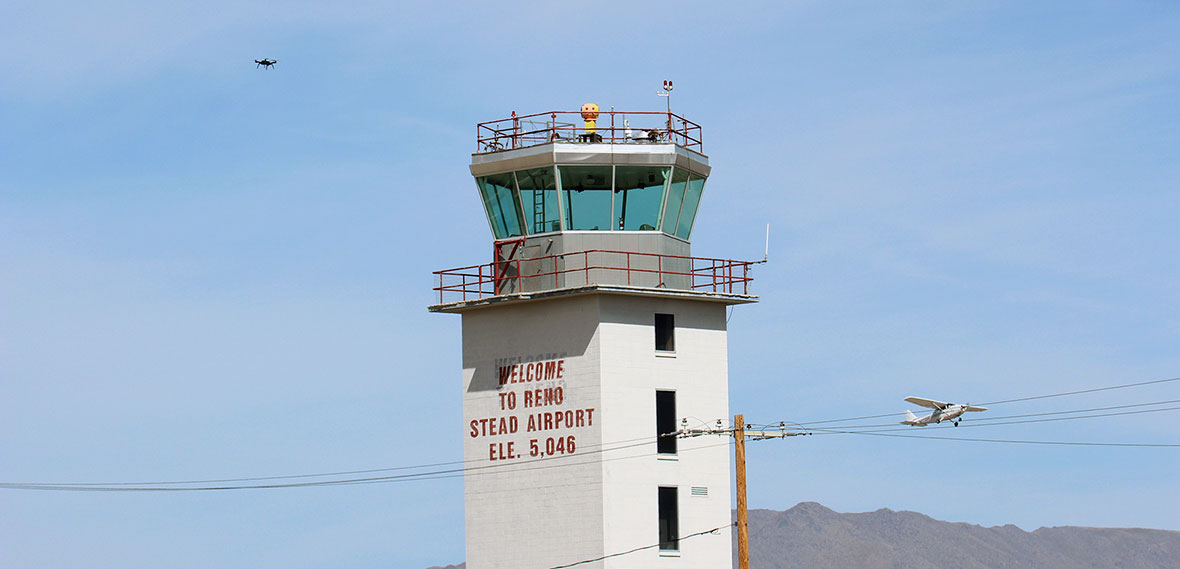Four autonomous unmanned aircraft flew simultaneously on pre-determined flight paths at the Reno-Stead Airport using software developed at the University of Nevada, Reno, in collaboration with the NASA Ames Research Center, in a milestone event that included 24 unmanned aircraft at six sites across the country.
NASA is researching various concepts for potential air traffic management platforms for low-altitude airspace and today's testing allowed several collaborators to demonstrate their independent software implementations. The University of Nevada, Reno team completed the three mission flights successfully with all four small unmanned aircraft and then completed a total of 32 flights, all successful, as NASA added virtual aircraft to the test for added complexity.
"It's exciting to be at the forefront of technological development," Richard Kelley, chief engineer for NAASIC, the University's autonomous robotic systems and intelligent machine research and industry collaboration, said. "We enjoyed working with the NASA team to explore UAS air traffic management concepts through this research platform. The software performed wonderfully, providing much-needed data and pointing towards open questions for the research community to address as we work to safely integrate unmanned aircraft into the National Airspace System."
Kelley is the lead scientist on the Nevada portion of the national project. Along with others around the country, he is working with NASA to develop the low altitude aircraft management software with the intent on making the airspace safer for aircraft.
"We'll be developing and testing several types of software that might integrate even small UAVs safely into the airspace, he said. "It's just beginning, and we've already had some successes as NASA continues researching various concepts for potential air traffic management platforms. It's great to be a part of history, with 24 aircraft across the country testing platforms all at once through the NASA project."
Kelley's team included College of Science researchers with their aircraft, as well as undergrad and graduate engineering students, some who developed software used today; all part of the larger team that included the Nevada Governor's Office of Economic Development, NIAS and two industry partners GC2IT and Flight Research Aerospace.
"Participating in the National Campaign gave Nevada undergraduate and graduate students the opportunity to explore critical issues surrounding the safe operation of unmanned aircraft in the National Airspace System," he said.
Each of the University's aircraft was tied into the NASA secure platform at the NASA-Ames UAV Command Center in California via laptops in the field, which also ran the University software controlling the quadcopters.
"The air traffic management research platform gave us a real-time view of our unmanned aircraft operations, enabling our team to operate safely and efficiently in multiple locations at the Reno-Stead Airport," Kelley said. "It was a bit hectic sticking to the strict schedule set by NASA, but we planned and prepared well leading up to the event and everyone performed well. It was a great first test flight with NASA at our new facility."
The testing milestone came just weeks after opening the Reno-Stead Airport based NUANCE Lab, a University of Nevada, Reno partnership with NASA, to conduct the airspace management research. But it didn't happen overnight.
"The University's relationship with NASA for the last two years has blossomed into this important leading-edge work," Warren Rapp, business director of NAASIC said. "We're fortunate to be supported by NIAS, who, as managers of the Nevada's FAA-approved test site, made the flights today for the NASA air traffic project possible."
NIAS, the Nevada Institute for Autonomous Systems, as well as the other five FAA designated autonomous systems test sites, partnered with NASA to make the sites available to researchers.
"Having NIAS leading the flight mission aspects through NASA was extremely helpful, enabling us to focus on the science and our research collaboration with NASA," Kelley said.
The NUANCE Lab houses a direct network connection to NASA Ames Research Center in Silicon Valley, allowing researchers to develop and test software for advanced aerospace concepts, including platforms to enable safer use of low-altitude airspace, of 500 feet and below, where autonomous aerial vehicles, helicopters, gliders and other general aircraft are operating.
NAASIC, the University's robotics and intelligent systems center, promotes the economic development of the autonomous systems industry in Nevada. NUANCE will also foster public-private partnerships in Nevada, as the University's NAASIC partners with aerospace companies, both small and large, to use the lab to strengthen and broaden Nevada's aerospace industry.
"Research such as this requires the capability for live feeds from the field - to modeling and simulation of airspace and to develop support tools and specifically for drones," Frank Aguilera, chair of NASA Ames Research Center's Airworthiness and Flight Safety Review Board, said at the NUANCE Lab's unveiling.
An article on the NASA Ames Research Center's website has the overview of the entire national test.












